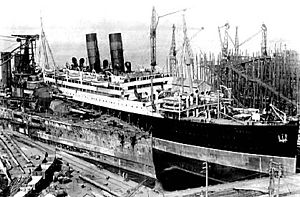RMS Andania (1913)
 RMS Andania at Scott's Yard alongside HMS Ajax
| |
| History | |
|---|---|
| Name | RMS Andania |
| Owner | Cunard S.S.Co Ltd, Liverpool |
| Builder | Greenock Dockyard Company by Scotts Shipbuilding and Engineering Company Ltd |
| Yard number | 446 |
| Launched | 22 March 1913 |
| Completed | 13 July 1913 |
| In service | [1] |
| Fate | Sunk by torpedo from U-46 27 January 1918 |
| General characteristics | |
| Class and type | passenger and cargo ship |
| Length | 158.58 m (520 ft 3 in) |
| Beam | 19.50 m (64 ft) |
| Installed power | eight quadruple-expansion engines |
| Propulsion | twin propellers |
| Speed | 15 knots (28 km/h; 17 mph) |
| Capacity | 520 second-class and 1,540 third-class passengers |
RMS Andania was a passenger and cargo ship from Great Britain launched 22 March 1913.[2] She was 13,405 tons and built in the Greenock Dockyard Company by Scotts Shipbuilding and Engineering Company Ltd and completed 13 July 1913.[2]
In World War I the Andania was used to transport the Royal Inniskilling Fusiliers and Royal Dublin Fusiliers to Cape Helles for the landings at Suvla. The landing at Suvla Bay by the British IX Corps was part of the August Offensive during the Battle of Gallipoli.
Description[]
The Andania measured 158.58 by 19.50 meters (520.3 ft × 64.0 ft) and had twin funnels and masts.[3] The hull was made of steel and the vessel was propelled by a twin propeller configuration, powered by eight quadruple-expansion engines creating a service speed of 15 knots.[3] The Andania held accommodations for 520 second-class and 1,540 third-class passengers.[3] Her sister ships were the Alaunia and Aurania which were almost identical and "cater(ed) only for second and third class passengers. The old-style third class dormitories were replaced by four or six-berth cabins."[3]
History[]
The Andania made its maiden voyage on 14 July 1913 from Liverpool via Southampton to Quebec and Montreal. In August 1914 it was requisitioned as a troopship and made several trips carrying Canadian troops. For a few weeks in 1915 the Andania was used to accommodate German POWs in the Thames. In the summer of 1915 it was used in the Gallipoli campaign when she was used to transport the Royal Inniskilling Fusiliers and Royal Dublin Fusiliers to Cape Helles for the landings at Suvla.[4]
After transporting more Canadian troops in 1916, it returned to passenger service in 1917 on the Liverpool-New York route. The Andania left Liverpool on 26 January 1918 with 40 passengers and a crew of around 200. It was part of a convoy of seven ships.[5] On 27 January the ship was hit amidships by a torpedo from German submarine U-46 captained by Leo Hillebrand two miles north-northeast of on Rathlin Island (County Antrim).[6] The ship immediately took a list to starboard and began to sink. Attempts were made to tow the ship but it sank after a few hours.[7] The passengers were saved, but Andania's sinking killed seven crew members.[3] The wreck is lying at a depth of between 175 and 189 metres.[8]
Gallery[]

at Altacarry Head has been flashing a warning to mariners since 1856.
Footnotes[]
- ^ On Wednesday 29 December 1915 she sailed from Devonport to Egypt (via malta) with the 13th and 14th York and lancaster Regiment - the 1st and 2nd Barnsley Pals.
- ^ a b "Search results for "1135481"". Miramar Ship Index. Retrieved 9 August 2009.
- ^ a b c d e "Andania I". Cunard Heritage. Retrieved 9 August 2009.
- ^ "Old Sedbergian Club web-site - accessed 10 November 09". Osclub.co.uk. Retrieved 17 April 2012.
- ^ "Los Angeles Herald". 13 February 1918. Retrieved 31 January 2018. Cite journal requires
|journal=(help) - ^ Helgason, Guðmundur. "Ships hit during WWI: Andania". German and Austrian U-boats of World War I - Kaiserliche Marine - Uboat.net. Retrieved 9 August 2009.
- ^ "LANDS 107 SURVIVORS OF STEAMER ANDANIA - No Lives Lost When Cunarder Was Sunk by U-Boat About Eleven Days Ago. 714 NORWEGIAN SHIPS SUNK. 53 Others Posted as Missing Since the War Began. - View Article - NYTimes.com" (PDF). New York Times. 14 February 1918. Retrieved 17 April 2012.
- ^ "Wreck Site -accessed 10 November 2009". Wrecksite.eu. Retrieved 17 April 2012.
Coordinates: 55°20′N 6°12′W / 55.333°N 6.200°W
- Ships of the Cunard Line
- Passenger ships of the United Kingdom
- World War I shipwrecks in the Atlantic Ocean
- Maritime incidents in 1918
- 1913 ships
- Ships sunk by German submarines in World War I
- Shipwrecks of Northern Ireland

